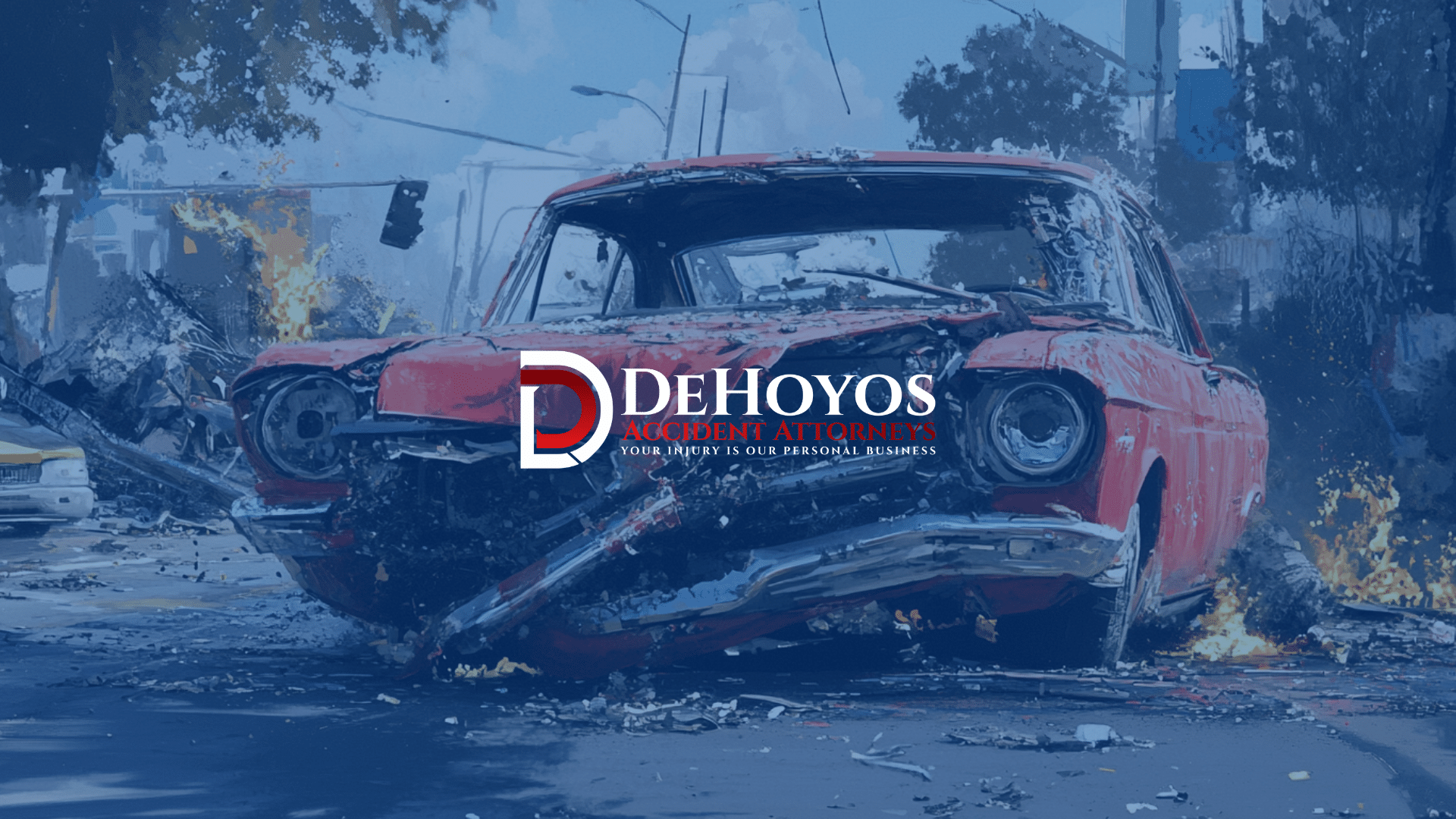Houston Personal Injury ATTORNEY
Who is at Fault in a Rear End Accident in Texas?

10+
YEARS OF PERSONAL EXPERIENCE
5-Star
RATING ON
GOOGLE REVIEWS
1,000+
CASES AND
CLIENTS
$20 M
IN SETTLEMENTS & VERDICTS
Although rear-end incidents are assumed in Texas to result from the car impacting from behind, this presumption is rebuttable when evidence shows that the lead driver behaved negligently or unpredictably.
Under Texas’s modified comparative negligence approach, drivers can share liability, affecting each party’s recovery in line with their allocated degree of blame.
Factors include unexpected stops without warning, faulty brake lights, and emergency movements might transfer or share blame; therefore, “who is at fault in a rear end accident” depends on a thorough assessment of the crash conditions.
Protecting your rights following a rear-end crash in Houston mostly depends on recording the situation, compiling witness accounts, and consulting a seasoned attorney.

Who Is at Fault in a Rear‑End Accident in Texas?
Following a rear-end collision in Texas, individuals immediately want to know who is legally liable. Texas law treats the driver who strikes someone from behind as presumptive negligent.
Finding who is to blame, though, is not always simple.
The fundamental conviction that all drivers have to maintain a safe following distance provides this initial presumption since it gives them adequate time to react and stop their vehicles before they collide with the one in front of them.
This idea also underlines the Texas Transportation Code (§545.062). Considering the state of the traffic now and the prospective hazards, drivers should regulate their speed and maintain enough distance between themselves and other vehicles.
This detailed inspection helps one realize that not every rear-end collision results from the fault of the car behind. Unexpected stops, faulty brake lights on the car in front, or dangerous and erratic driver movements ahead can all influence liability.
At DeHoyos Accident Attorneys, we understand that in a rear-end collision, assigning responsibility simply marks the beginning of the investigation.
Our knowledgeable attorneys thoroughly investigate every case, meticulously compiling data and analyzing all the elements causing the accident to identify the true liability.
Standard Exceptions to the Presumption
Texas law often holds that in a Texas rear-end collision, the rear driver is at fault. This is not absolute, though. These are typical exceptions:
Sudden, Unjustified Stops:
Suppose the automobile in front slows down suddenly for no apparent reason, such as brake-checking—that driver may share or be entirely at fault. The following drivers are not supposed to predict such behavior.
Brake Light Malfunction:
If the brake lights of the front car fail, the rear driver may not have adequate warning to stop, therefore mitigating their fault. Drivers anticipate brake lights working.
Reversing Vehicle:
Usually, regardless of who strikes whom, the reversing driver is responsible when a car backs up and results in a crash. Supporting back-up calls with more care.
Careful examination can reveal that the lead driver was at fault or shared culpability since “car rear ended” accidents can have complicated causes. Lawyers such as those found at DeHoyos Accident Attorneys review these specifics.
Contributing Factors in Rear‑End Collision Fault
Several driving behaviors and conditions commonly influence fault determinations in rear end car accident cases:
Tailgating:
Following too closely deprives the rear driver of reaction time; it is one of the most cited causes of fault in rear‑end wrecks.
Distracted Driving:
Texting or cell‑phone use delays response, heightening risk and often assigning fault to the rear driver.
Speeding:
High speeds reduce stopping distance and exacerbate crash severity; speed‑related rear‑end collisions frequently place fault on the faster vehicle.
Sudden Stops:
Legitimate emergency stops (e.g., avoiding a collision with a pedestrian) can relieve some fault from the rear driver, provided they can show the stop was necessary and unavoidable.
Weather & Road Conditions:
Wet roads or poor visibility require greater following distances; failure to adjust may implicate either driver depending on circumstances.
Recognizing these factors is essential when determining rear end collision fault—and underscores the importance of a thorough accident reconstruction.
Comparative Negligence in Texas Rear‑End Crashes
Texas applies a modified comparative negligence framework under Civil Practice & Remedies Code §33.001. This means:
- A driver can recover damages only if they are 50% or less at fault.
- Their percentage of responsibility reduces any award.
- If deemed 51% or more at fault, they cannot recover compensation.
For instance, if a court assigns 30% fault to the lead driver for braking unexpectedly and 70% to the rear driver, the rear driver would be entitled to 30% of their total damages. This system incentivizes clear evidence-gathering to minimize assigned fault.
Evidence to Determine Fault in Rear‑End Collisions
Building a compelling case on who is at fault in a rear end collision requires:
- Police Reports:
Official crash reports document officer observations, diagramming impact points and skid marks
- Photographic Evidence:
Photos of vehicle damage, roadway conditions, and brake‑light status preserve critical visual data.
- Witness Statements:
Independent testimonies can corroborate or dispute each driver’s account.
- Video Footage:
Traffic‑camera or dash‑cam recordings offer objective crash timelines and distances.
- Accident Reconstruction:
Experts analyze vehicle speeds, angles, and momentum to pinpoint fault distribution.
The twisted metal, the lingering trauma – these are the marks of a rear-end crash.
Determining fault demands strong evidence. We gather police reports, the official record, stark photos of the damage, crucial witness statements, objective video footage, and expert accident reconstruction. Don’t let insurers minimize your suffering.
Contact DeHoyos Accident Attorneys now. Swift evidence collection is key to fighting for the compensation you need to heal. Let us be your voice for justice.
Multi‑Vehicle and Chain‑Reaction Rear‑End Collisions
Rear ended car accident blame investigations are complicated by chain-reaction incidents, in which one vehicle rear-ends another, creating a domino effect. In these regards:
Liability could cover later drivers who stop after the first impact and the first striking driver.
If front car drivers were cut off or braked incorrectly, they could be blamed for starting the sequence.
Uncovering who hit whom and at what speeds depends on a complete accident reconstruction.
Legal knowledge is essential for allocating responsibility and following relevant claims since several parties and insurance policies are involved.
What to Do After a Rear‑End Collision in Houston
Taking prompt action can protect your interests in a rear-end car accident:
- Seek Medical Attention:
Even if injuries seem minor, delayed symptoms (e.g., whiplash) can emerge hours later.
- Report the Crash:
File a police report and obtain a copy for your records.
- Document the Scene:
Photograph vehicle positions, damage, and road conditions.
- Collect Information:
Exchange insurance/driver details and gather witness contacts.
- Avoid Recorded Statements:
Insurers may twist your words to deny or devalue your claim.
- Consult a Houston Car Accident Injury Lawyer:
Early legal advice ensures evidence is preserved and deadlines met; visit our Houston car accident injury lawyer page.
These steps lay the groundwork for accurately determining rear end collision fault and maximizing recovery.
Common Myths About Rear‑End Accident Fault
It’s easy to fall prey to common misunderstandings about who is at fault in a rear-end collision. Let’s clarify some key myths:
Myth: The rear driver is always at fault.
Fact: While often presumed, Texas law acknowledges that the front driver can share or even bear full fault if their negligent or unexpected actions contributed to the crash. This includes scenarios like sudden, unjustified stops or failing to signal properly.
Myth: Whiplash cases are frivolous.
Fact: Don’t underestimate whiplash. It can cause significant chronic pain and long-term disability. Settling your whiplash claim too early without fully documenting your treatment and the impact on your life can lead to undervaluing your injury.
The National Highway Traffic Safety Administration (NHTSA) recognizes the potential severity of whiplash.
Myth: Insurance adjusters are on your side.
Fact: Remember, insurance adjusters work for the insurance company, whose primary goal is often to limit payouts. Having legal representation levels the playing field, ensuring your rights are protected and your claim is valued fairly
Dispelling these misconceptions helps you approach your claim strategically and avoid costly mistakes.
Why You Should Consult DeHoyos Accident Attorneys
Determining who is at fault in a rear end accident often involves nuanced legal and factual issues. At DeHoyos Accident Attorneys, our Houston team:
- Conducts thorough crash investigations with leading reconstruction experts.
- Challenges insurer presumptions and negotiates aggressively on your behalf.
- Applies Texas comparative negligence law to minimize your assigned fault
- Pursues litigation when necessary to secure fair compensation for medical bills, lost wages, property damage, and pain and suffering.
Do not rely just on our word for it. On our testimonials page, you may read personal stories of how we have assisted clients in navigating complex accident cases. Visit our Ryan A. DeHoyos page to learn more about the committed attorney ready to advocate for you.
Trust the knowledgeable team at DeHoyos Accident Attorneys to give the clarity and strong advocacy you require when the complexity of rear-end accident blame leaves you feeling uncertain. Get in touch now for a free consultation to enable us to guide you toward justice.
Contact the Houston Rear-End Accident Lawyers at DeHoyos Accident Attorneys for Help Today!
Don’t let confusion over fault derail your recovery. If you’ve been in a car rear ended collision in Houston, contact us for a free consultation. We’ll help you understand liability, protect your rights, and pursue the compensation you deserve.
Get started with DeHoyos Accident Attorneys – no fees unless we win.
FAQs about fault in Texas rear-end accidents:
FAQ 1: Is the rear driver always automatically at fault in Texas?
While Texas law presumes the rear driver is negligent for not maintaining a safe distance, this isn’t absolute. Fault can shift if the lead driver acted negligently (e.g., sudden, unjustified stop).
FAQ 2: Can the lead driver ever be found at fault in a rear-end collision in Texas?
Yes. If the lead driver’s actions contributed to the crash, such as brake-checking or having malfunctioning brake lights, they may share or bear fault.
FAQ 3: What evidence is used to determine fault in a Texas rear-end accident?
Evidence includes police reports, photos of damage, witness statements, video footage (if available), and accident reconstruction analysis to understand the crash dynamics.
FAQ 4: How does Texas’s comparative negligence law affect fault in rear-end accidents?
Texas uses modified comparative negligence. If you’re partially at fault (under 51%), you can still recover damages, but your award is reduced by your fault percentage.
FAQ 5: What should I do if I’m in a rear-end accident in Texas and believe the other driver was at fault?
Document everything, including photos and witness info. Avoid admitting fault. Contact a Texas car accident lawyer to investigate and protect your rights.
Do I need a personal injury lawyer to file a claim?
What should I do after an injury
What can I recover after a personal injury?
How should I prepare for my personal injury consultation?
Who can file a personal injury lawsuit in Texas?
How much is my personal injury case worth in Texas?
What is considered “maintenance and cure”?
$2,000,000
CAR ACCIDENT SETTLEMENT
$1,130,000
PEDESTRIAN SETTLEMENT
$1,100,000
SPINAL CORD INJURY
$955,000
PEDESTRIAN ACCIDENT
$1,300,000
CAR ACCIDENT SETTLEMENT
$980,000
CAR ACCIDENT SETTLEMENT
$960,000
MOTORCYCLE ACCIDENT
$850,000
SLIP & FALL SETTLEMENT
$250,000
LONG-TERM DISABILITY
A personal approach to personal injury in Houston, Texas
“As a client to this Law Firm, I found it to be rewarding base on their work ethics. With there expertise, knowledge, flexibility and being responsive to their client needs. They will see that their client receive the best outcome on there case. There are many people out there that have bad ideas about lawyers, but DeHoyos Accident Attorneys will make sure that you’re not stressed about anything pertaining to your case. I’ll recommend that you seek this Lawyer and Law Firm for any unraveling situation you might face.”
RIDLEY OSBOURNE
“I can’t say enough good things about DeHoyos Accident Attorneys! Mr. Ryan DeHoyos is extremely knowledgeable in his field of Personal Injury. I was injured in a motor vehicle accident last year and Mr. DeHoyos stopped at nothing to get me the compensation I deserved. He kept me updated on my case regularly and guided me to get the medical care I needed. Additionally, his staff is so kind and caring, especially Ashley… Thank you, DeHoyos Accident Attorneys for your professionalism in closing my case…and WINNING big!”
RAVEN DOLBERRY














